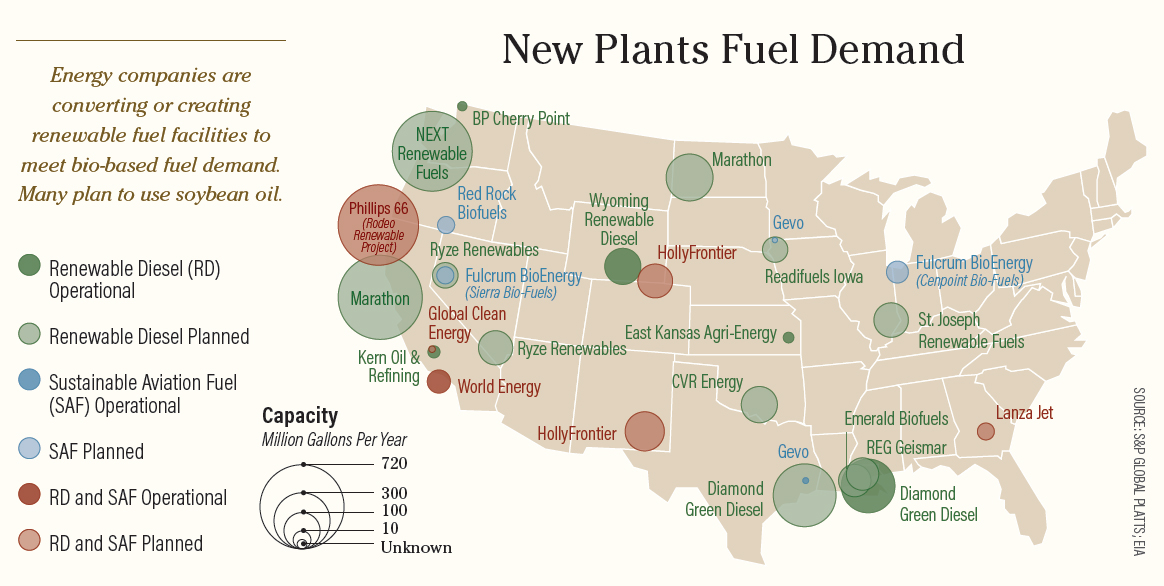Fuel the Crush: Renewable Diesel Pumps Up Soybean Demand

Big change is afoot. Those soybeans growing in your fields have traditionally been valued by the meal they produce and animals they feed. Soon their oil content could pad your pocketbook.
Public policy to reduce carbon emissions is fueling demand for bio-based fuels. Low Carbon Fuel Standards are in place in California and Oregon, and several other states are considering them. These rules call for conventional petroleum fuels, such as gasoline and diesel, to be replaced with more carbon-friendly fuels.
“The administration is committed to making this happen, and so I think there is a much larger appetite to get this industry off the ground now than there even was six months or a year ago,” says Alexa Combelic, director of government affairs for the American Soybean Association.
Enter renewable diesel. While it is a cousin of biodiesel, the two fuels are not the same. Renewable diesel, which is produced by processing fats and vegetable oils, is chemically the same as petroleum diesel and has nearly identical performance characteristics. Plus, it is 100% fuel, removing the need for blending it with diesel.

“Based on projections, total supplies of edible fats and oils in the U.S. will need to double over the next decade to meet the feedstock needs of the renewable diesel industry,” says Stephen Nicholson, Rabo AgriFinance senior analyst for grains and oilseeds. “Feedstock from waste oils, tallow or vegetable oils is limited, so it’s likely large volumes of vegetable oils will be used. This should create consistent high demand for oilseeds.”
As a result, nearly $2.6 billion will be invested in North America crushing assets within the next three years, Nicholson says.
AN ETHANOL MOMENT
The dramatic development of the U.S. renewable diesel industry is similar to how ethanol changed the U.S. corn industry from 2007 to 2010, says Dan Basse, president of AgResource Company. But he believes renewable diesel could be more disruptive.
“We are calling for 90.5 million soybean acres in 2022 versus this year’s 87 million, and that just gets us started in meeting renewable diesel demand,” he says. “Then we’d need to increase soybean acres by 5 million to 7 million each year. We have to top 120 million acres of soybeans to meet the growing demand for renewable diesel.”

More acres will be needed, as well as higher yields.
“From a farmer’s perspective, particularly those around current or future crushing facilities, there will be an economic incentive to plant more soybeans,” Nicholson adds. “Based on previous studies, soybean basis could increase as much as 15¢ to 30¢ near these large crushing plants.”
BIG OIL INVESTS IN AGRICULTURE
The difference in renewable diesel versus ethanol or biodiesel is a framework already in place. “This is not building a new industry,” Basse says. “Instead, we are retrofitting an existing industry with people who have a lot of money.”

Five plants are currently producing renewable diesel. Future growth will come as previous petroleum refineries are converted to produce bio-based fuels. These plants are owned by some of the largest energy companies in the world.
“The biggest risk for these companies is assuring enough feedstock,” Basse says. “That’s why we are seeing these firms partner with prevailing producers of soy products.”
Energy companies investing with ag companies include:
- Chevron partnering with Bunge to expand facilities in Destrehan, La., and Cario, Ill.
- Love’s entering a joint venture with Cargill to build a plant in Hastings, Neb.
- Marathon partnering with ADM to build a soybean plant in Spiritwood, N.D.
In Iowa, Phillips 66 has invested in Shell Rock Soy Processing, which broke ground last year. In return, Phillips receives access to 100% of the plant’s soy oil, says Mike Kinley, managing member of Ag Development Group.
“Our target is to be able to receive soybeans in July of 2022 and then to be able to crush soybeans in December of 2022,” Kinley says.
When at full capacity, the plant will crush 38.5 million bushels of soybeans annually (110,000 bu. per day). A second soy crushing facility from the group (Platinum Crush in Buena Vista County, Iowa) will be online in 2023.
OIL VERSUS MEAL
One bushel of soybeans creates, on average, 10.7 lb. of crude soy oil and 47.5 lb. of soybean meal. “As this market develops, I’m guessing many will wish those were reversed,” Basse says. “If this has some staying power, you’ll see soybeans bred for more oil going forward.”
Renewable diesel could revolutionize the U.S. soybean industry, says Pete Meyer, head of grain and oilseed analytics, S&P Global Platts.
“We will start crushing for oil instead of meal by 2025,” he says. “The U.S. export system will have to evolve, and that means U.S. soybeans and soy oil stay here and all that soy meal is exported.”

The U.S. has capacity to produce about 900 million gallons of renewable diesel this year and 2.1 billion next year, says Bill Lapp, president of Advanced Economic Solutions. “If you believe all the investments, it could soon be 6 billion gallons. We just won’t have enough feedstock to make it.”
Canola is a promising feedstock, although EPA has yet to approve a pathway for canola-based renewable diesel, but that will change as the industry grows and more feedstocks are needed.
Even then, Lapp says it will be difficult to find enough tallow, used cooking oil, grease, soy oil, corn oil and canola oil to satisfy renewable diesel demand.
As such, Meyer says soybean oil could make up 70% of the total demand picture for renewable diesel and sustainable aviation fuel. That’s more than a hill of beans.
Read, watch and listen to more insights about renewable diesel.
Sara Schafer, content manager for Farm Journal and editor of Top Producer, knows asking good questions creates the most useful stories. She uses her Missouri farm roots to cover innovative operations, business topics and more.







